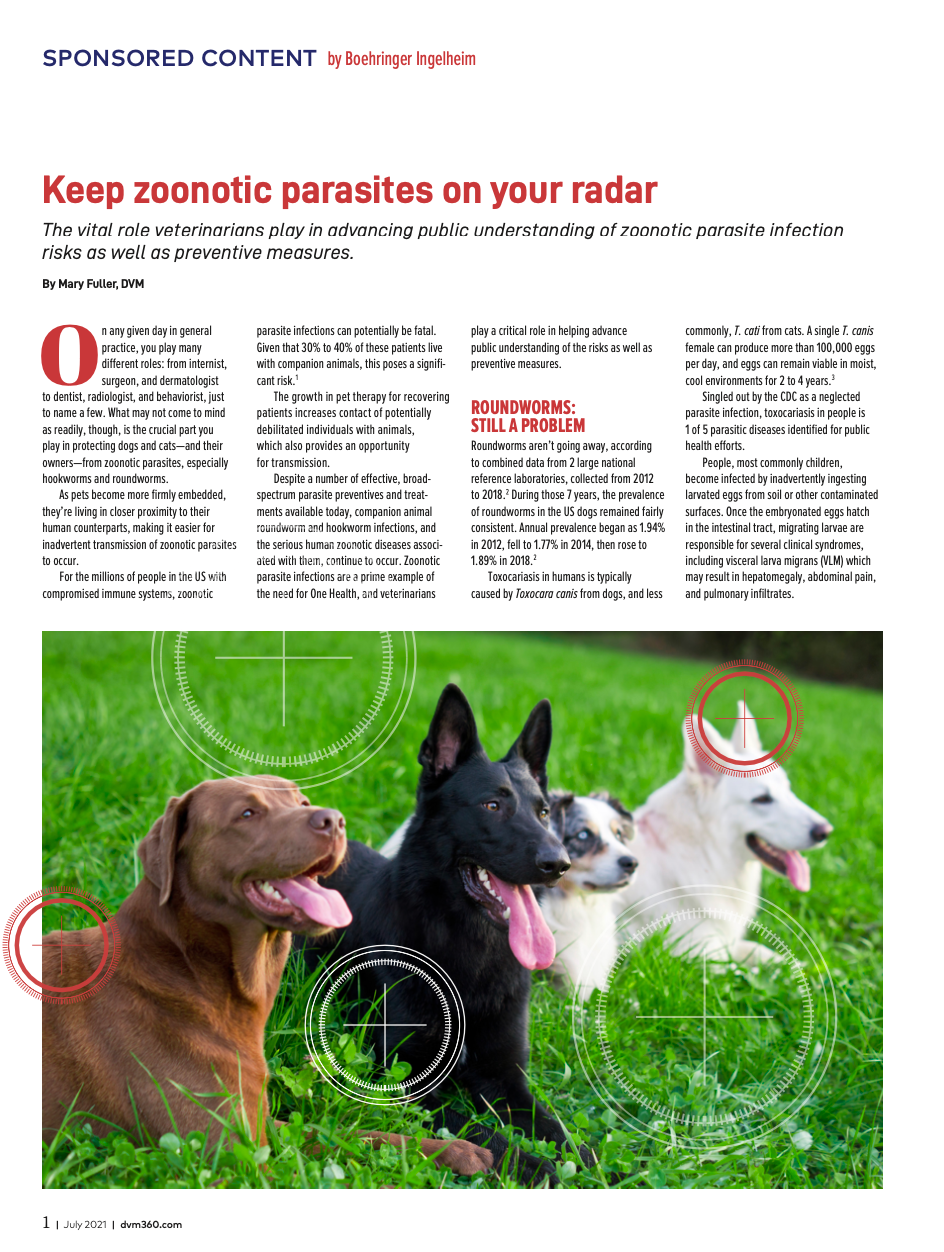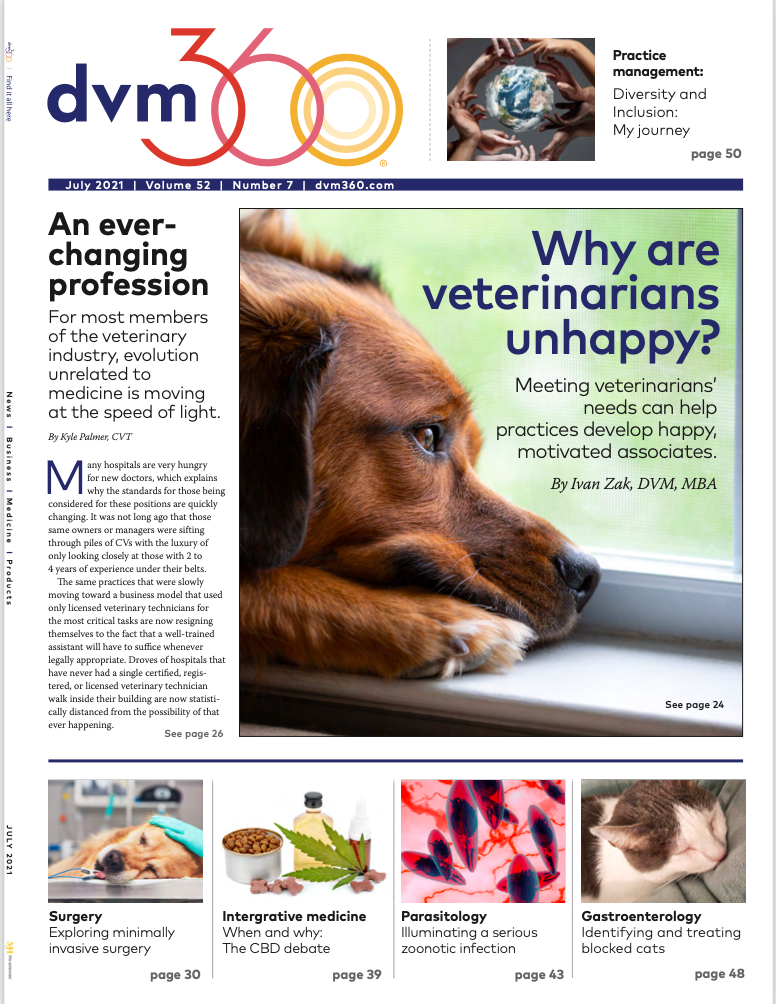On any given day in general practice, you play many different roles: from internist, surgeon, and dermatologist to dentist, radiologist, and behaviorist, just to name a few. What may not come to mind as readily, though, is the crucial part you play in protecting dogs and cats—and their owners—from zoonotic parasites, especially hookworms and roundworms.
As pets become more firmly embedded, they’re living in closer proximity to their human counterparts, making it easier for inadvertent transmission of zoonotic parasites to occur.
For the millions of people in the US with compromised immune systems, zoonotic parasite infections can potentially be fatal. Given that 30% to 40% of these patients live with companion animals, this poses a significant risk.1
The growth in pet therapy for recovering patients increases contact of potentially debilitated individuals with animals, which also provides an opportunity for transmission.
Despite a number of effective, broad-spectrum parasite preventives and treatments available today, companion animal roundworm and hookworm infections, and the serious human zoonotic diseases associated with them, continue to occur. Zoonotic parasite infections are a prime example of the need for One Health, and veterinarians play a critical role in helping advance public understanding of the risks as well as preventive measures.
Roundworms: Still a problem
Roundworms aren’t going away, according to combined data from 2 large national reference laboratories, collected from 2012 to 2018.2 During those 7 years, the prevalence of roundworms in the US dogs remained fairly consistent. Annual prevalence began as 1.94% in 2012, fell to 1.77% in 2014, then rose to 1.89% in 2018.2
Toxocariasis in humans is typically caused by Toxocara canis from dogs, and less commonly, T. cati from cats. A single T. canis female can produce more than 100,000 eggs per day, and eggs can remain viable in moist, cool environments for 2 to 4 years.3
Singled out by the CDC as a neglected parasite infection, toxocariasis in people is 1 of 5 parasitic diseases identified for public health efforts.
People, most commonly children, become infected by inadvertently ingesting larvated eggs from soil or other contaminated surfaces. Once the embryonated eggs hatch in the intestinal tract, migrating larvae are responsible for several clinical syndromes, including visceral larva migrans (VLM) which may result in hepatomegaly, abdominal pain, and pulmonary infiltrates.
For migrating larvae that happen to reach the eyes, ocular larva migrans (OLM) has the potential to cause permanent vision loss. Hundreds of children in the US are estimated to experience unilateral vision loss and other illnesses each year due to toxocaral larva migrans.4,5
Toxocariasis can also lead to neural larval migrans (NLM) causing progressive neurological signs and covert toxocariasis with abdominal pain, headaches and other vague symptoms.
Hookworms: Growing in importance
The prevalence of hookworms in US dogs increased from 2.02% in 2012 to 2.96% in 2018, a 47% jump over the previously reported annual prevalence (P < 0.0001).2
Dogs and cats of any age can harbor adult hookworms in the small intestine, which pass eggs into the host’s gut, additionally larval hookworms encyst in the tissue. Outside the host, eggs hatch in the feces, and infective larvae migrate out of the feces and can survive in the soil and vegetation for 3 to 4 weeks when environmental conditions are right.3,4 Humans are typically infected when larvae penetrate the skin.
A. braziliense is the hookworm most often associated with cutaneous larva migrans (CLM), or “creeping eruption” in people, but A. caninum and U. stenocephala have also been implicated.7,8
Affected people experience linear, serpentine lesions that can be intensely pruritic, but infections are generally self-limiting. There is evidence that A. caninum infection may impact tissues beyond the skin, leading to eosinophilic enteritis, and possibly a form of ocular larva migrans that may impact vision.8
A gap between veterinary and human doctors
A Connecticut survey revealed a disconnect between veterinarians and pediatricians in terms of who is primarily responsible for educating people on zoonotic diseases. In a ranking of 4 occupations, veterinarians generally felt physicians were primarily responsible for communicating with the public, while pediatricians chose public health officials first, followed by veterinarians.9
Only 6% of pediatricians felt comfortable discussing parasitic disease prevention with clients, compared to 45% of veterinarians.9 Of those participating in the same survey, 60% of pediatricians and 41% of veterinarians never consulted those in the other profession about zoonotic diseases.9
But who do pet owners look to for information on zoonotic disease? In a survey of dog owners, 40% cited their veterinarian as their primary resource for zoonotic disease information, while not a single respondent mentioned their primary physician as a source.10
Zoonoses: Possible legal implications for veterinarians
Due to the potential severity of human diseases associated with zoonotic parasite infection, there are a number of scenarios where veterinarians could be tangled up in legal action. If a child or other family member becomes infected, veterinarians could face disciplinary action or litigation for failing to diagnose the parasitic disease in the pet, or simply neglecting to recommend parasite preventive measures. Even if parasitic infection is diagnosed in a pet, a veterinarian could still be at risk for failing to advise clients to talk to their physician about possible zoonotic parasite transmission. The best way to protect patients, clients, and your practice is to have a proactive parasite program in place. Start by educating the staff and clients about the risks of zoonotic parasites and the importance of prevention and treatment. Veterinarians should make a point to note client discussions about zoonotic parasites in medical records. It’s also important to record when clients decline fecal tests, diagnostic testing, parasite preventives, or treatment (better yet, keep forms on hand and ask for client signatures to verify their choices). With any pets that pose a risk for zoonotic parasite transmission, pet owners should be advised to seek the care of their physicians. In the spirit of OneHealth, veterinarians should be willing to discuss the situation with the physician, as needed.
Educate clients on zoonotic parasites
You need to educate clients about the significance of deworming puppies and kittens, not just for the health of the patients, but to help protect their family members from zoonotic parasites.
Clients also need to understand the importance of year-round, broad-spectrum parasite prevention, with products that treat and control both hookworms and roundworms.
Finally, you should explain why regular fecal testing is necessary for monitoring the effectiveness of prevention and treatment efforts, so their pets and family remain protected.
Teach clients about sanitary measures
While underscoring the importance of proactive deworming and parasite prevention with clients, it’s actually more important for veterinarians to educate clients about proper sanitary measures to help prevent zoonotic parasite transmission.
Since veterinarians aren’t always aware when clients or their family members may be immunocompromised, consider placing a small sign in exam rooms or a note on the practice website to encourage discussion of zoonotic disease risks and measures to limit the potential for transmission.
All pet owners should be advised to:
- Pick up and dispose of pet feces promptly—When walking in public areas such as parks, schoolyards, and city streets, dog owners should adhere to leash laws as well as bag and dispose of pet feces immediately. Pet feces in the yard and garden should be cleaned up as soon as possible and shoes and gloves should be worn when gardening.
- Keep children away from potentially contaminated areas—When not in use, sandboxes should be covered to prevent contamination with feces from cats and other animals. Kids should be discouraged from letting pets lick their mouths.
- Wash hands with soap and water—All clients, especially those with children or immunocompromised family members, should wash hands after handling dogs, cats, animal waste, or pet supplies such as food and water bowls, pet beds, and litter boxes. Hand washing is especially important before eating food or handling infants, pacifiers, and baby bottles.
Since pet owners don’t always remember what you tell them, reinforce the message with educational brochures on zoonotic parasites. The Centers for Disease Control and Prevention (CDC) has produced an excellent brochure that you can share with your clients: “What every pet owner should know about roundworms and hookworms." This brochure is available online at www.cdc.gov/parasites/ resources/roundworms_hookworms.html. Your Boehringer Ingelheim representative can also provide you hard copies of the brochure for free, to share with clients.
References
- Angulo FJ, Glaser CA, Juranek DD, et al. Caring for pets of immunocompromised persons. J Am Vet Med Assoc. 1994;205(12):1711-1718.
- Drake J, Carey T. Seasonality and changing prevalence of common canine gastrointestinal nematodes in the USA. Parasites Vectors. 2019;12 (430). doi.org/10.1186/ s13071-019-3701-7.
- Lloyd S. Toxocarosis In: Palmer SR, Soulsby L, Simpson DIH, eds. Zoonosis. New York: Oxford University Press 1998;842.
- Glickman LT, Schantz PM. Epidemiology and pathogenesis of zoonotic toxocariasis. Epidemiol Rev. 1981;3:230-250.
- Schantz PM. Toxocara larva migrans now. Am J Trop Med Hyg. 1981;41(suppl):21-34.
- Companion Animal Parasite Council. Hookworms. Available at: https://capcvet.org/guidelines/hookworms/. Accessed May 14, 2021.
- Centers for Disease Control and Prevention. Parasites — Zoonotic hookworm, biology. Available at: www.cdc.gov/parasites/zoonotichookworm/biology.html. Accessed April 28, 2021.
- Bowman DD, Montgomery SP, Zajac AM, et al. Hookworms of dogs and cats as agents of cutaneous larva migrans. Trends Parasitol. 2010;26(4):162-167. doi.org/10.1016/j. pt.2010.01.005.
- Gauthier JL, Richardson DJ. Knowledge and attitudes about zoonotic helminths: a survey of Connecticut pediatricians and veterinarians. Compend Contin Educ Pract Vet 2002;24(suppl):4-9.
- Sandhu GK, Singh D. Level of awareness regarding some zoonotic diseases, among dog owners of Ithaca, New York. J Family Med Prim Care 2014;3(4):418-423. doi: 10.4103/2249-4863.148132

